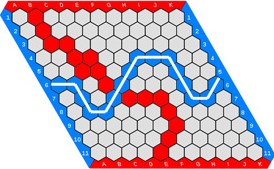CTYI Game Theory Information
"We often hear that mathematics consists mainly of 'proving theorems'. Is a writer's job mainly that of 'writing sentences'?" - Gian-Carlo Rota.

 Here is the course outline. Here is our Handbook that we used for the course.
Here is the course outline. Here is our Handbook that we used for the course.
Here is the Grade Game Handout that we spoke about in class (the one from Yale).
Here is the mixed strategies handout that we spoke about in class (the one from Yale).
Here's the Game Theory Handout regarding mixed strategy Nash equilibria & how to calculate them for the weekend. Have a read and ask me questions!
Finally, here's a blank Hex board courtesy of Wikipedia.
Image credit; Wikipedia.
When we spoke about the game Order and Chaos, we used the following material:
The Order and Chaos Wikipedia page.
Solving Order and Chaos, a paper demonstrating from an empty board, perfect play on both sides leads to an Order win.
The Order and Chaos webapp, giving the strategy for an Order win.
The mathematical theory for the game of Nim.
When we spoke about the game Bagh-Chal, we used the following material:
The Wikipedia page for Bagh-Chal, also known as Tigers and Goats.
Computing Tigers and Goats, a paper claiming "partial results show that Tigers appears to have the better part of the opening, but Goats may catch up in the long run."
Play against a computer Tiger in this online game of Tigers and Goats.
When we spoke about the Hex Theorem, we used the following material:
An Inductive Proof of Hex Uniqueness by Samuel Clowes Huneke; a proof that there can be no more than one winner in a game of Hex.
Some Games and Machines for Playing Them by John Nash, talking a bit about Hex.
The Hex Theorem and Brouwer's Fixed Point Theorem - proof the theorems are equivalent (and more proofs involving the Hex Theorem).
Finally, this is a link to Econ 159, a game theory course taught at Yale University by Professor Ben Polak. I encourage you to continue your study of game theory by watching his lectures!
U.S.-China Trade Relation Information: Link 1 and Link 2 starting from page 4.

 Here is the course outline. Here is our Handbook that we used for the course.
Here is the course outline. Here is our Handbook that we used for the course.